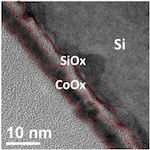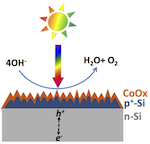
 Artificial photosynthesis is achieved by using light to split water into hydrogen and oxygen. Recently, researchers at the Joint Center for Artificial Photosynthesis (JCAP), utilizing three of the National User Facilities at Berkeley Lab, were able to address one of the major challenges in artificial photosynthesis – the stabilization of semiconductor materials under the harsh conditions required for water splitting. The Physical Biosciences Division’s Ian Sharp led the team that developed and tested this novel method, published recently in the Journal of the American Chemical Society. Utilizing advanced nanofabrication capabilities at the Molecular Foundry, Jinhui Yang of the Material Sciences Division deposited a thin layer of an oxygen evolution catalyst, cobalt oxide, onto silicon electrodes that had been nanotextured for improved stability and efficiency. Cross-sectional transmission electron microscopy was performed at the National Center for Electron Microscopy to visualize the interfaces of the modified semiconductor. Using Beamline 10.3.1 at the Advanced Light Source, scientists employed x-ray absorption near edge spectroscopy to ascertain the chemical composition of the photoelectrode and its changes following operation. This careful characterization helps to establish the success and utility of this approach for improving the performance and stability of silicon electrodes by engineering the catalyst/semiconductor interface. These results open up new possibilities for stabilizing high efficiency semiconductors for solar energy conversion to chemical fuel.
Artificial photosynthesis is achieved by using light to split water into hydrogen and oxygen. Recently, researchers at the Joint Center for Artificial Photosynthesis (JCAP), utilizing three of the National User Facilities at Berkeley Lab, were able to address one of the major challenges in artificial photosynthesis – the stabilization of semiconductor materials under the harsh conditions required for water splitting. The Physical Biosciences Division’s Ian Sharp led the team that developed and tested this novel method, published recently in the Journal of the American Chemical Society. Utilizing advanced nanofabrication capabilities at the Molecular Foundry, Jinhui Yang of the Material Sciences Division deposited a thin layer of an oxygen evolution catalyst, cobalt oxide, onto silicon electrodes that had been nanotextured for improved stability and efficiency. Cross-sectional transmission electron microscopy was performed at the National Center for Electron Microscopy to visualize the interfaces of the modified semiconductor. Using Beamline 10.3.1 at the Advanced Light Source, scientists employed x-ray absorption near edge spectroscopy to ascertain the chemical composition of the photoelectrode and its changes following operation. This careful characterization helps to establish the success and utility of this approach for improving the performance and stability of silicon electrodes by engineering the catalyst/semiconductor interface. These results open up new possibilities for stabilizing high efficiency semiconductors for solar energy conversion to chemical fuel.




